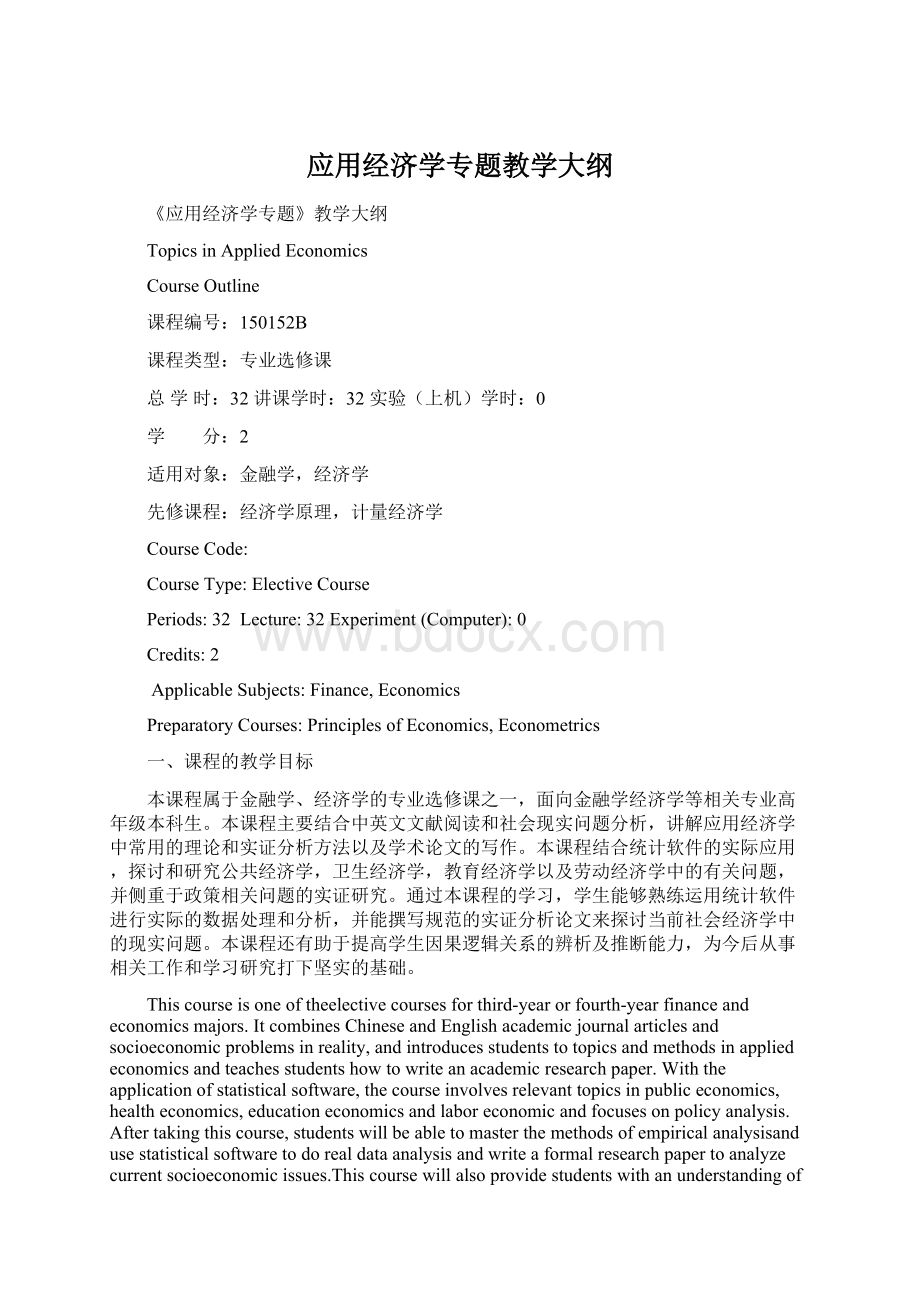应用经济学专题教学大纲.docx
《应用经济学专题教学大纲.docx》由会员分享,可在线阅读,更多相关《应用经济学专题教学大纲.docx(11页珍藏版)》请在冰豆网上搜索。

应用经济学专题教学大纲
《应用经济学专题》教学大纲
TopicsinAppliedEconomics
CourseOutline
课程编号:
150152B
课程类型:
专业选修课
总学时:
32讲课学时:
32实验(上机)学时:
0
学 分:
2
适用对象:
金融学,经济学
先修课程:
经济学原理,计量经济学
CourseCode:
CourseType:
ElectiveCourse
Periods:
32Lecture:
32Experiment(Computer):
0
Credits:
2
ApplicableSubjects:
Finance,Economics
PreparatoryCourses:
PrinciplesofEconomics,Econometrics
一、课程的教学目标
本课程属于金融学、经济学的专业选修课之一,面向金融学经济学等相关专业高年级本科生。
本课程主要结合中英文文献阅读和社会现实问题分析,讲解应用经济学中常用的理论和实证分析方法以及学术论文的写作。
本课程结合统计软件的实际应用,探讨和研究公共经济学,卫生经济学,教育经济学以及劳动经济学中的有关问题,并侧重于政策相关问题的实证研究。
通过本课程的学习,学生能够熟练运用统计软件进行实际的数据处理和分析,并能撰写规范的实证分析论文来探讨当前社会经济学中的现实问题。
本课程还有助于提高学生因果逻辑关系的辨析及推断能力,为今后从事相关工作和学习研究打下坚实的基础。
Thiscourseisoneoftheelectivecoursesforthird-yearorfourth-yearfinanceandeconomicsmajors.ItcombinesChineseandEnglishacademicjournalarticlesandsocioeconomicproblemsinreality,andintroducesstudentstotopicsandmethodsinappliedeconomicsandteachesstudentshowtowriteanacademicresearchpaper.Withtheapplicationofstatisticalsoftware,thecourseinvolvesrelevanttopicsinpubliceconomics,healtheconomics,educationeconomicsandlaboreconomicandfocusesonpolicyanalysis.Aftertakingthiscourse,studentswillbeabletomasterthemethodsofempiricalanalysisandusestatisticalsoftwaretodorealdataanalysisandwriteaformalresearchpapertoanalyzecurrentsocioeconomicissues.Thiscoursewillalsoprovidestudentswithanunderstandingofgeneralmethodologyinappliedempiricalresearch,improvetheirlogicalthinkingandlayafoundationforfuturework.
二、教学基本要求
本课程主要讲述公共经济学等应用经济学领域的研究理论与实证分析方法。
本课程要求学生大量阅读应用经济学领域的中英文文献和研究报告,进行课堂讨论和报告展示,并完成一篇课题论文。
该课程侧重训练学生深入理解实证分析中的因果推断问题,掌握科学的分析方法,并且能够独立提出和解决有现实意义的社会经济学问题。
本课程授课方式采用教师主讲、课后文献阅读和学生课堂展示相结合。
教师结合课程教材及文献,系统讲授文献中计量模型分析及应用。
学生根据教师分配的任务,两人一组进行相关研究主题的课堂展示,要求学生对所展示的内容进行深入理解并能提出独立的看法和见解。
课程的考核方式为课堂展示,作业和学术论文。
课堂展示20%,平时作业3次占30%,学术论文占50%。
学术论文应该主题明确,可行性强,本课程中间需提交学术论文的开题简介,最后学生还需对自己的论文进行课堂展示。
\
Thiscoursefocusedonresearchtheoriesandmethodsinappliedeconomicsfieldssuchaspubliceconomics.Studentsarerequiredtoreadresearchpapersandreportsinappliedeconomics,participateinclassdiscussionsandpresentations,andcompletearesearchpaper.Studentsshouldunderstandandmastertheeconometricmethodstoestimatecausaleffects,andproposepracticalsocioeconomicresearchquestionsindependently.Thiscourseisacombinationoflectures,presentationsandreadings.Instructorswillteachgeneralmethodologyinappliedresearchwork.Studentsarerequiredtopresentoneortworesearchpapersinclass.Studentsarerequiredtopresentasynopsisofthepaperandprovidetheirowncommentaryontheresearchtopic.
Thefinalgradeofthiscoursewillbebasedontwopresentations(20%),threeassignments(30%)andaresearchpaper(50%).Theresearchpapershouldaddressaclearlystateddoableresearchquestion.Aproposaloftheresearchpaperisdueinthemiddleoftheterm.Finallythestudentsarerequiredtopresenttheirresearchprojectinclass.
三、各教学环节学时分配
以表格方式表现各章节的学时分配,表格如下:
序号
章节内容
讲课
实验
其他
合计
1
应用经济学导论
2
2
2
STATA基础应用
1
1
2
3
经济学分解分析方法及应用
4
2
6
4
STATA统计分析
1
1
2
5
论文选题及要求
2
2
6
处理效应及政策评估
6
2
8
7
工具变量回归方法及应用
4
2
6
8
中国社会保障制度专题
2
2
9
学术论文写作
2
2
合计
24
2
6
32
教学课时分配
ClassSchedule
No.
ChapterContents
Teaching
Experiment
Other
Total
1
IntroductiontoAppliedEconomics
2
2
2
STATAIntroduction
1
1
2
3
DecompositionMethodsandApplicationsinEconomics
4
2
6
4
STATAApplications
1
1
2
5
RequirementsforResearchPaperProposal
2
2
6
TreatmentEffectsandProgramEvaluation
6
2
8
7
InstrumentalVariablesRegressionandApplications
4
2
6
8
SocialSecuritySysteminChina
2
2
9
TipsforWritingResearchPapers
2
2
合计
24
2
6
32
四、教学内容
第一章应用经济学导论
第一节实证分析
1.实证分析
2.实证研究
第二节数据
1.数据的类别与性质
2.常用数据库介绍
教学重点、难点:
计量分析方法
课程的考核要求:
理解实证分析,了解主要的计量分析方法和特点,了解微观数据的获取途径
复习思考题:
1.简述实证分析
2.如何获取研究所需数据
第二章STATA基础应用
第一节数据探究与描述
第二节计算机操作
教学重点、难点:
运用STATA对数据进行基本的描述性分析
课程的考核要求:
掌握STATA描述性分析的基本命令,运用命令分析具体数据
复习思考题:
描述数值类变量的命令有哪些
第三章经济学分解分析方法及应用
第一节均值分解
1.分解的类别与方法
2.Oaxaca-Blinder分解
3.详细分解与举例
第二节分位数分解
1.分位数回归
2.RIF回归
3.分位数分解
教学重点、难点:
分位数回归与分解的理解与运用
课程的考核要求:
掌握Oaxaca-Blinder分解的理论与方法,了解分位数回归的理论与方法,运用Oaxaca-Blinder分解或分位数分解方法解决实际问题
复习思考题:
1.Oaxaca-Blinder分解有几种方法及如何解释分解结果
2.如何解释分位数分解的结果
第四章STATA应用
第一节线性与非线性回归分析
第二节分解分析
第三节计算机操作
教学重点、难点:
分位数分解
课程的考核要求:
运用STATA进行经济学分解分析
复习思考题:
简述分位数分解的步骤
第五章论文的选题及要求
第一节论文选题
1.经济学论文的特点
2.如何进行论文选题
3.举例
第二节论文选题的要求
教学重点、难点:
如何进行论文选题
课程的考核要求:
初步了解论文选题的过程
第六章处理效应及政策评估
第一节处理效应
第二节处理效应的估计方法
1.非实验数据
2.非参方法
3.回归方法
4.匹配方法
5.倍差法
第三节政策评估
教学重点、难点:
处理效应的估计
课程的考核要求:
掌握处理效应的几种估计方法,会运用匹配法和倍差法估计处理效应
复习思考题:
1.简述处理效应的几种估计方法
2.倍差法与匹配法估计的假设前提是什么
第七章工具变量回归方法及应用
第一节内生性与工具变量
1.内生性变量
2.工具变量的要求
第二节工具变量回归
1.两步最小二乘估计
2.一般工具变量估计
第三节工具变量估计应用
教学重点、难点:
两步最小二乘估计方法与应用
课程的考核要求:
理解工具变量的适用范围,掌握和运用两步最小二乘法进行工具变量估计
复习思考题:
1.简述内生性变量和外生性变量
2.如何选取有效的工具变量
第八章中国社会保障制度专题
第一节中国医疗系统
1.医疗系统简介
2.医疗保障系统
3.医生人力资源
第二节中国养老保险研究
教学重点、难点:
社会保障相关问题的实证研究
课程的考核要求:
了解中国社会保障制度的现状,并运用所学知识对社会保障问题进行分析
第九章学术论文写作
第一节论文的结构
1.论文简介写作
2.文献综述与导论
3.文章主体
4.结论
第二节学术诚信
教学重点、难点:
学术论文的结构设计和导论写作
课程的考核要求:
规范完成本课程的课题论文
1IntroductiontoAppliedEconomics
1.1EmpiricalAnalysis
1.1.1EmpiricalAnalysis
1.1.2EmpiricalResearch
1.2Data
1.2.1DataTypes
1.2.2IntroductiontoCommonlyUsedDataset
KeyandDifficultPoints:
EconometricAnalysis
EvaluationRequirements:
Understandingtheconceptofempiricalanalysis,knowingeconometricmethodsandfeaturesingeneral,knowinghowtoobtainmicroeconomicdata.
Problems:
1.ConceptofEmpiricalAnalysis
2.Howcanweobtainmicroeconomicdata
2STATAIntroduction
2.1DataExplorationandDescription
2.2ComputerProgramming
KeyandDifficultPoints:
UseSTATAtododescriptiveanalysis
EvaluationRequirements:
KnowhowtouseSTATAtododescriptiveanalysis
Problems:
STATAcommandsforsummarystatistics
3DecompositionMethodsandApplicationsinEconomics
3.1MeanDecomposition
3.1.1DecompositionMethodsandTypes
3.1.2Oaxaca-BlinderDecomposition
3.1.3DetailedDecompositionandApplications
3.2DecompositionforQuantiles
3.2.1QuantileRegression
3.2.2RIFRegression
3.2.3DecompositionforQuantiles
KeyandDifficultPoints:
RIFregressionanddecomposition
EvaluationRequirements:
MasterOaxaca-Blinderdecompositionmethod,knowquantileregressionandmethod,applyOaxaca-Blinderandquantiledecompositionmethods
Problems:
1.InterprettheresultsofOaxaca-Blindermeandecomposition
2.Interprettheresultsofdecompositionofquantiles
4STATAApplications
4.1LinearandNonlinearRegressionAnalysis
4.2DecompositionAnalysis
4.3ComputerProgramming
KeyandDifficultPoints:
DecompositionofquantilesusingSTATA
EvaluationRequirements:
UseSTATAtododecompositionanalysisineconomics
Problems:
Describethestepsofdecompositionofquantiles
5RequirementsforResearchPaperProposal
5.1WaystoSelectaResearchTopic
5.1.1CharacteristicsofEconomicResearchPapers
5.1.2WaystoSelectaResearchTopic
5.1.3Examples
5.2RequirementsforResearchPaperProposal
KeyandDifficultPoints:
Howtoselectaresearchtopic
EvaluationRequirements:
Befamiliarwiththeprocessofselectingaresearchtopic
6TreatmentEffectsandProgramEvaluation
6.1TreatmentEffects
6.2EstimationofTreatmentEffects
6.2.1NonparametricEstimation
6.2.2RegressionMethod
6.2.3MatchingMethod
6.2.4Difference-in-differences
6.3ProgramEvaluation
KeyandDifficultPoints:
Estimationoftreatmenteffects
EvaluationRequirements:
Masterthemethodsoftreatmenteffectestimation,applymatchinganddifference-in-differencestoestimatetheimpactofaprogram
Problems:
1.Describemethodsoftreatmenteffectestimation
2.Whataretheidentifyingassumptionsformatchingmethodanddifference-in-differencesestimation
7InstrumentalVariablesRegressionandApplications
7.1EndogeneityandInstrumentalvariables
7.1.1EndogenousVariables
7.1.2ConditionsforInstrumentalVariables
7.2InstrumentalVariablesRegression
7.2.1TwoStageLeastSquaresEstimator
7.2.26.2.2.GeneralIVRegression
7.3IVRegressionApplications
KeyandDifficultPoints:
TwoStageLeastSquaresEstimationandApplications
EvaluationRequirements:
UnderstandwhentouseIVregression,applytwostageleastsquaresestimationusingrealdata
Problems:
1.Describeendogenousvariablesandexogenousvariables
2.Howcanwefindavalidinstrument
8SocialSecuritySysteminChina
8.1HealthCareSysteminChina
8.1.1IntroductiontoHealthCareSysteminChina
8.1.2HealthInsuranceinChina
8.1.3HumanResourceIssuesintheHealthCareSector
8.2PensionSysteminChina
KeyandDifficultPoints:
EmpiricalstudiesofsocialsecuritypoliciesinChina
EvaluationRequirements:
KnowthestatusofsocialsecuritysysteminChina,applytheempiricalmethodstoanalyzerealsocioeconomicsproblems
9TipsforWritingResearchPapers
9.1StructureofaResearchPaper
9.1.1Abstract
9.1.2LiteratureReviewandIntroduction
9.1.3MainBodyo
9.1.4Conclusion
9.2AcademicHonesty
KeyandDifficultPoints:
Structureofaresearchpaperandhowtowritetheintroduction
EvaluationRequirements:
Completetheresearchpaper
五、其它
本课程教学每周都有阅读应用经济学文献的任务。
Asetofreadingswillbeassignedtostudentseveryweek.
六、主要参考书
列出主要参考书目,所列条目及其顺序如下:
[1]Angrist,J.andPischkeJ.S.,MostlyHarmlessEconometrics,Princeton,NewJersey,USA,PrincetonUniversityPress,2009
[2]Benjamin,D.,Gunderson,M.andLemieux,T.,LabourMarketEconomics,6thEdition,Ontario,Canada,McGraw-HillRyersonHigherEducation,2007
[3]Folland,S.,Goodman,